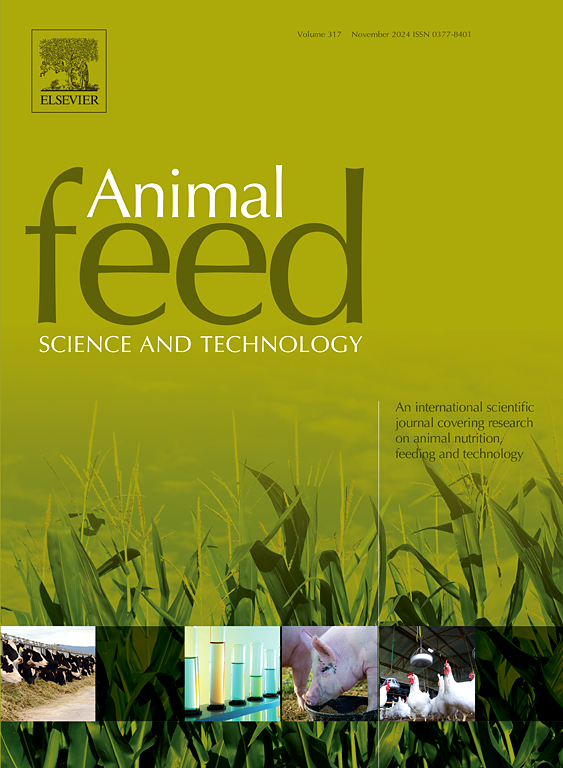挤压工艺对微丸物理性质和尼罗罗非鱼幼鱼生长性能的影响
IF 2.5
2区 农林科学
Q1 AGRICULTURE, DAIRY & ANIMAL SCIENCE
引用次数: 0
摘要
本研究旨在评估不同挤压工艺对微丸物理特性的影响,以及这些改变如何影响尼罗罗非鱼幼鱼的生长性能。四种实验日粮配方相同,但挤压工艺不同:CE:冷挤压(18 ºC);HE:热挤压(100 ºC);D1:双挤压,首先对所有成分进行热挤压(100 ºC),然后进行冷挤压(18 ºC);D2:双挤压,首先对植物性成分进行热挤压(100 ºC),然后与动物性成分混合并研磨,最后进行冷挤压(18 ºC)。幼年罗非鱼(0.83 ± 0.01 克;3.68 ± 0.19 厘米)按完全随机设计被分配到 20 个实验单元(60 升;n=5;每个单元 20 条鱼),为期四周。HE 试验日粮的微颗粒呈现正膨胀率(2.86 ± 0.45 %)和较低的体积密度(465.9 ± 3.45 g/L)。D1 和 D2 微丸的体积密度较高(分别为 671.0 ± 2.98 和 612.8 ± 4.99 克/升)。所有微丸都表现出较高的耐久性(95%)。D2 微丸的抗水性较低(24.4 ± 3.51 %),导致养分浸出率较高(68 %)。HE 和 D1 微丸在水中的吸收率较高(分别为 3.65 ± 0.29 和 3.66 ± 0.21 克水/克)。微丸的水溶性指数不受不同挤压工艺的影响(P > 0.05),存活率和饲料消耗量也不受影响。饲喂 HE 日粮的鱼增重较大(3.84 ± 0.44 g),而饲喂 CE 日粮的鱼增重最小(3.05 ± 0.39 g)(P <0.05)。饲喂 HE(1.06)和 D1(1.11)日粮的鱼的饲料转化率较低(P < 0.05)。饲喂 HE 日粮的鱼的相对生长率(9.08 ± 0.62 %/d)、蛋白质保留率(30.6 ± 2.61 %)和蛋白质效率(2.26 ± 0.22 %)值最高(P <0.05)。饲喂 CE 日粮的鱼的相对生长率(7.82 ± 0.51 %/d)、蛋白质保留率(21.4 ± 2.72 %)和蛋白质效率(1.55 ± 0.23 %)的值最低(P <0.05),尽管这些值与文献中的值一致。总之,热挤压可获得物理性质更好的微颗粒,鱼的生长性能也更高。不建议采用双重挤压法,即先热挤压植物性成分,然后与动物性成分混合并碾磨,最后进行冷挤压,因为这样会造成营养物质的大量沥出。冷挤压和双挤压,即先热挤压所有配料,然后进行冷挤压加工,可用于生产罗非鱼幼鱼的微量日粮,尤其是在希望减少挤压过程投资的情况下。本文章由计算机程序翻译,如有差异,请以英文原文为准。
Effects of the extrusion process on the physical properties of micro pellets and the growth performance of juvenile Nile tilapia
The present study aimed to evaluate the effect of different extrusion processes on the physical properties of micro pellets and how the alterations affect the growth performance of juvenile Nile tilapia. Four experimental diets were produced with the same formulation, but with different extrusion processes: CE: cold extrusion (18 ºC); HE: hot extrusion (100 ºC); D1: double extrusion, first a hot extrusion (100 ºC) of all the ingredients followed by cold extrusion (18 ºC); D2: double extrusion, first a hot extrusion (100 ºC) of the plant-based ingredients followed by mixing with the animal-based ingredients and milling, then cold extrusion (18 ºC). Juvenile tilapia (0.83 ± 0.01 g; 3.68 ± 0.19 cm) were distributed in 20 experimental units (60 L; n=5; 20 fish per unit) in a completely randomized design for four weeks. The micro pellets of the experimental HE diet presented a positive expansion rate (2.86 ± 0.45 %) and a lower bulk density (465.9 ± 3.45 g/L). The D1 and D2 micro pellets presented higher bulk density (671.0 ± 2.98 and 612.8 ± 4.99 g/L, respectively). All the micro pellets showed high durability (>95 %). The D2 micro pellets showed low water resistance (24.4 ± 3.51 %), resulting in a high leaching rate of nutrients (>68 %). The HE and D1 micro pellets showed a higher absorption rate in water (3.65 ± 0.29 and 3.66 ± 0.21 g water/g, respectively). The water solubility index of the micro pellets was not influenced by the different extrusion processes (P > 0.05), nor were survival and feed consumption. The fish fed with the HE diet showed greater weight gain (3.84 ± 0.44 g), and the lowest weight gain was in the fish fed with the CE diet (3.05 ± 0.39 g) (P < 0.05). Feed conversion was lower in fish fed the HE (1.06) and D1 (1.11) diets (P < 0.05). Fish fed the HE diet had the highest values for relative growth rate (9.08 ± 0.62 %/d), protein retention (30.6 ± 2.61 %) and protein efficiency (2.26 ± 0.22 %) (P < 0.05). Fish fed the CE diet had the lowest values for relative growth rate (7.82 ± 0.51 %/d), protein retention (21.4 ± 2.72 %) and protein efficiency (1.55 ± 0.23 %) (P < 0.05), though the values are in line with those in the literature. In conclusion, hot extrusion resulted in micro pellets with better physical properties and fish with higher growth performance. Double extrusion, first a hot extrusion of the plant-based ingredients followed by mixing with the animal-based ingredients and milling, then cold extrusion is not recommended due to high levels of nutrient leaching. Cold extrusion and double extrusion, first a hot extrusion of all the ingredients followed by cold extrusion processing can be considered for producing micro diets for juvenile tilapia, especially when less investment in the extrusion process is desired.
求助全文
通过发布文献求助,成功后即可免费获取论文全文。
去求助
来源期刊

Animal Feed Science and Technology
农林科学-奶制品与动物科学
CiteScore
6.00
自引率
6.20%
发文量
266
审稿时长
3 months
期刊介绍:
Animal Feed Science and Technology is a unique journal publishing scientific papers of international interest focusing on animal feeds and their feeding.
Papers describing research on feed for ruminants and non-ruminants, including poultry, horses, companion animals and aquatic animals, are welcome.
The journal covers the following areas:
Nutritive value of feeds (e.g., assessment, improvement)
Methods of conserving and processing feeds that affect their nutritional value
Agronomic and climatic factors influencing the nutritive value of feeds
Utilization of feeds and the improvement of such
Metabolic, production, reproduction and health responses, as well as potential environmental impacts, of diet inputs and feed technologies (e.g., feeds, feed additives, feed components, mycotoxins)
Mathematical models relating directly to animal-feed interactions
Analytical and experimental methods for feed evaluation
Environmental impacts of feed technologies in animal production.
 求助内容:
求助内容: 应助结果提醒方式:
应助结果提醒方式:


